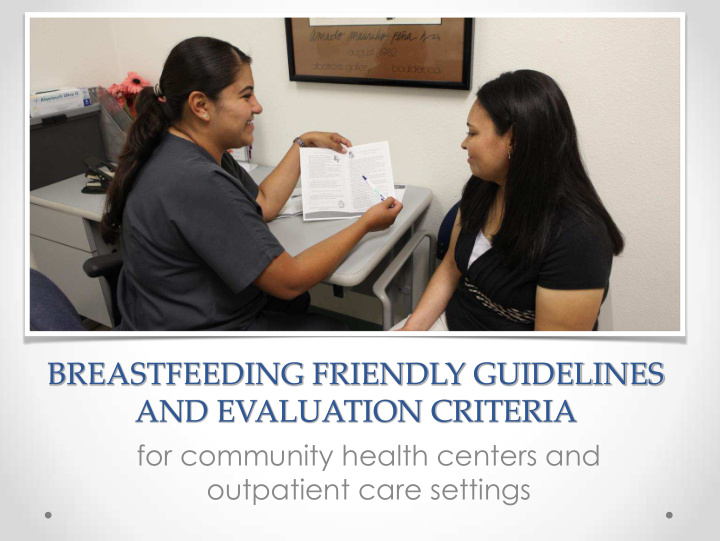



BREASTFEEDING FRIENDLY GUIDELINES AND EVALUATION CRITERIA for community health centers and outpatient care settings
Expert Advisory Board
Expert Advisory Board met for 10 months bimonthly
We looked at…
Joint Meeting April 30 th , 2013
Breastfeeding-Friendly Guidelines and Evaluation Criteria for Community Health Centers and Outpatient Care Settings
STEP 1: POLICY AND PROTOCOLS Establish and routinely communicate to all clinic staff a written feeding policy that promotes, supports and protects breastfeeding and human milk as the normative standard for infant feeding and nutrition.
Policy and Protocols Guidelines 1. Develop policy 2. Communicate policy 3. Display policy 4. Create and implement protocols
STEP 2: STAFF EDUCATION AND EVALUATION Provide initial and ongoing competency-based education and training for all clinic staff on topics necessary to establish and maintain the infant feeding policy and protocols that support delivery of comprehensive breastfeeding education and clinical services.
• Guidelines feature: o Assess staff training needs o Develop training plans o Implement competency based education and training
• Guidelines also feature: o Evaluate clinical-based infant feeding and breastfeeding skills o Have access to a breastfeeding expert
• Criteria for Evaluation o Written training plans o Staff training timeline
• Other criteria for evaluation o Training records with: • Timeline for skills evaluation • Appropriate skills for area of clinical practice o Documented access to a breastfeeding expert
STEP 3: INFANT FEEDING EDUCATION Provide accurate and evidence-based information about breastfeeding and human milk to all pregnant women, mothers and/or caretakers that is based on current nationally recognized guidelines.
• Guidelines feature: o Encouragement to exclusively breastfeed or feed infants only human milk o Review of normal infant behaviors: sleep, crying, and infant feeding cues
• Guidelines also feature: o Differences in breastfeeding, human milk and artificial milk (formula) o Dyad ’ s health and developmental benefits of breastfeeding and human milk o Management of successful breastfeeding
• Criteria for evaluation: o Written information provided as education o Documentation of patient reporting services provided o Documentation of educational encounters, in medical records
In Conclusion • These steps align with this learning objective: o Communicate expectation to all staff using skills-based competencies appropriate to training and role in patient care.
STEP 4: CLINICAL SERVICES Provide clinical services that promote and support breastfeeding for the mother-baby dyad as optimal infant feeding and nutrition.
STEP 5: CLINICAL ENVIRONMENT Establish, provide, and maintain a breastfeeding- friendly clinic environment.
STEP 6: COMMUNITY RESOURCES Collaborate with local agencies and health professionals to ensure continuity of care and breastfeeding support in the community.
STEP 7: WORKPLACE LACTATION ACCOMMODATIONS Provide and maintain effective lactation accommodation for all employees within the organization.
• Department of Health and Human Services has recognized that there are “alarming” disparities in breastfeeding rates across racial and socio-economic lines • The Centers for Disease Control and Prevention (CDC) has also found that 60% of women cannot even meet their own breastfeeding goals Melissa Bartick, MD, MSc and Marsha Walker, RN, IBCLC - USBC 2011
Where are the disparities?
Provisional Breastfeeding Rates Among Children Born in 2007 Breastfeeding at 12 13% Non-Hispanic Black or African Months (%) 28% American 58% Breastfeeding at 6 25% Months (%) Hispanic or Latino 46% 81% Ever Breastfed (%) 33% Asian or Pacific Islander 56% 83% 21% American Indian or Alaska 42% Native 74% 22% United States 43% 75% 0% 20% 40% 60% 80% 100% U.S. Department of Health and Human Services. The Surgeon General’s Call to Action to Support Breastfeeding. Washington, DC: U.S. Department of Health and Human Services, Office of the Surgeon General; 2011.
California breastfeeding rates by race/ethnicity 2011
Baby-Friendly vs. traditional
High breastfeeding=low Medi-Cal
Why do the disparities exist?
Labbok M, Taylor E. Achieving Exclusive Breastfeeding in the United States: Findings and Recommendations. Washington, DC: United States Breastfeeding Committee; 2008.
STEP 8: FINANCIAL SUSTAINABILITY Develop a financial plan that guides provision of breastfeeding services in a way that maximizes sustainability in the context of overall health services and resources provided.
Financial Sustainability • Financial plan • Support for billing codes • Incorporation of financial planning for lactation services into the EHR
Auditing
STEP 9: QUALITY IMPROVEMENT AND IMPACT EVALUATION Establish systems of data tracking, quality assurance, continuous quality improvement and impact evaluation.
Quality Improvement • Maternal-infant feeding outcomes • Referrals to IBCLCs as appropriate • Evidence of collaboration with WIC, regional and statewide agencies • Comparisons of clinic data with published data
Questions?
Recommend
More recommend